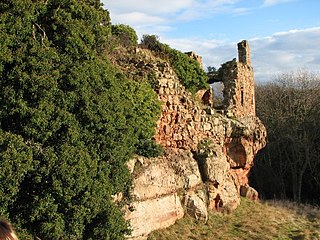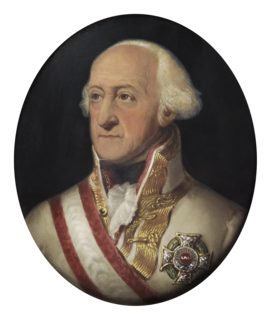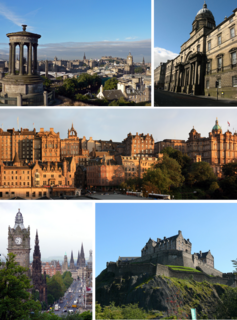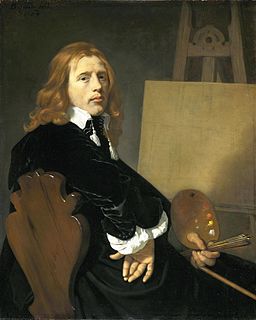
Thomas Phillips RA was a leading English portrait and subject painter. He painted many of the great men of the day including scientists, artists, writers, poets and explorers.

David Allan was a Scottish painter and illustrator, best known for historical subjects and genre works. He was born at Alloa in central Scotland. On leaving Foulis's academy of painting at Glasgow (1762), after seven years' successful study, he obtained the patronage of Lord Cathcart and of Erskine of Mar, on whose estate he had been born. Erskine made it possible for him to travel to Rome (1764), where he remained until 1777, studying under Gavin Hamilton and copying the old masters.

Alexander Nasmyth was a Scottish portrait and landscape painter, a pupil of Allan Ramsay.

Sir William Allan was a distinguished Scottish historical painter known for his scenes of Russian life. He became president of the Royal Scottish Academy and was made a Royal Academician.

Horatio McCulloch, sometimes written MacCulloch or M'Culloch, was a Scottish landscape painter.

Sir William Boxall was an English painter and museum director.

Robert Salmon was a maritime artist, active in both England and America. Salmon completed nearly 1,000 paintings, all save one of maritime scenes or seascapes. He is widely considered the Father of American Luminism.

Innerwick is a coastal civil parish and small village, which lies in the east of East Lothian, 5 miles (8.0 km) from Dunbar and approximately 32 miles (51 km) from Edinburgh.

William Kidd H.R.S.A. was a prolific Scottish artist known for his comic depictions of cosy domestic scenes in romantic-era Scotland and England. He also illustrated works of various authors including Sir Walter Scott and Robert Burns.
Frederick W. Watts was an English landscape painter influenced by Constable. He has been known as "Frederic William Watts", "Frederick Waters Watts", "William Watts" or "William Frederick Watts".

William Essex, was an English enamel-painter. He was the chief mid-nineteenth-century exponent of enamel painting, an art which had been extended from portrait miniatures to larger enamel plaques by Henry Bone in the early nineteenth century.
Alfred Essex, was an English enamel-painter, who worked with his brother William Essex to popularise enamel painting in the nineteenth century.

Art in early modern Scotland includes all forms of artistic production within the modern borders of Scotland, between the adoption of the Renaissance in the early sixteenth century to the beginnings of the Enlightenment in the mid-eighteenth century.

Scottish art in the nineteenth century is the body of visual art made in Scotland, by Scots, or about scottish subjects. This period saw the increasing professionalisation and organisation of art in Scotland. Major institutions founded in this period included the Institution for the Encouragement of the Fine Arts in Scotland, the Royal Scottish Academy of Art, the National Gallery of Scotland, the Scottish National Portrait Gallery and the Glasgow Institute. Art education in Edinburgh focused on the Trustees Drawing Academy of Edinburgh. Glasgow School of Art was founded in 1845 and Grays School of Art in Aberdeen in 1885.

Scottish art in the eighteenth century is the body of visual art made in Scotland, by Scots, or about Scottish subjects, in the eighteenth century. This period saw development of professionalisation, with art academies were established in Edinburgh and Glasgow. Art was increasingly influenced by Neoclassicism, the Enlightenment and towards the end of the century by Romanticism, with Italy becoming a major centre of Scottish art.

Portrait painting in Scotland includes all forms of painted portraiture in Scotland, from its beginnings in the early sixteenth century until the present day. The origins of the tradition of portrait painting in Scotland are in the Renaissance, particularly through contacts with the Netherlands. The first portrait of a named person that survives is that of Archbishop William Elphinstone, probably painted by a Scottish artist using Flemish techniques around 1505. Around the same period Scottish monarchs turned to the recording of royal likenesses in panel portraits, painted in oils on wood. The tradition of royal portrait painting in Scotland was probably disrupted by the minorities and regencies it underwent for much of the sixteenth century. It began to flourish after the Reformation, with paintings of royal figures and nobles by Netherlands artists Hans Eworth, Arnold Bronckorst and Adrian Vanson. A specific type of Scottish picture from this era was the "vendetta portrait", designed to keep alive the memory of an atrocity. The Union of Crowns in 1603 removed a major source of artistic patronage in Scotland as James VI and his court moved to London. The result has been seen as a shift "from crown to castle", as the nobility and local lairds became the major sources of patronage.

Landscape painting in Scotland includes all forms of painting of landscapes in Scotland since its origins in the sixteenth century to the present day. The earliest examples of Scottish landscape painting are in the tradition of Scottish house decoration that arose in the sixteenth century. Often said to be the earliest surviving painted landscape created in Scotland is a depiction by the Flemish artist Alexander Keirincx undertaken for Charles I.

Scottish genre art is the depiction of everyday life in Scotland, or by Scottish artists, emulating the genre art of Netherlands painters of the sixteenth and seventeenth centuries. Common themes included markets, domestic settings, interiors, parties, inn scenes, and street scenes.



















